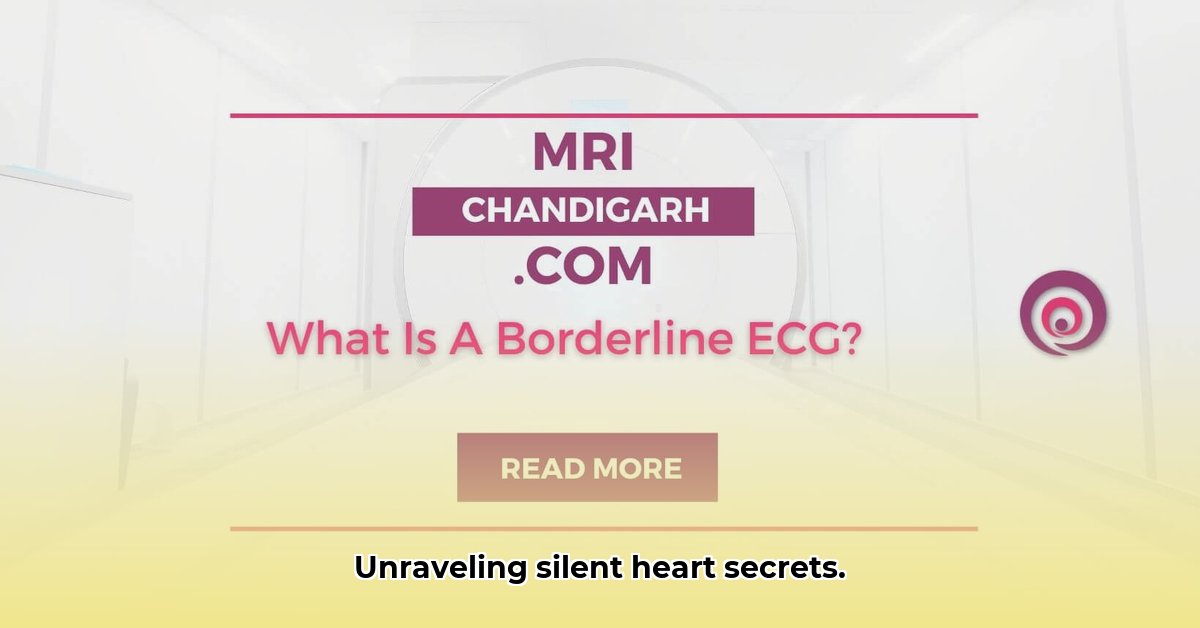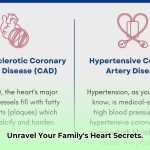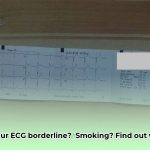An unclear EKG result can be a little scary, especially when you feel perfectly fine. This comprehensive guide will help you understand what a “borderline” EKG means, what might cause it, and what steps you should take. We’ll break down the information clearly, so you can confidently discuss your concerns with your doctor, make the best choices for your heart health, and understand how doctors approach these results, considering various factors. This guide aims to help you make sense of the situation and ensure your heart stays healthy for years to come. For more in-depth information, see this helpful resource on borderline ECGs.
Borderline ECG: Interpreting Uncertain Heart Test Results and Understanding Long QT Syndrome
Receiving a “borderline” result on your electrocardiogram (ECG) – a test that checks your heart’s electrical activity – can be unsettling. It’s not a diagnosis itself, but it indicates that something needs a closer look. It presents an opportunity to ensure long-term heart health. Think of it as your doctor finding a clue that requires further investigation to solve a health mystery.
Understanding What a Borderline ECG Means in Heart Health Assessment
A borderline ECG in an asymptomatic patient (meaning you have no symptoms) simply means the results aren’t perfectly normal, but they aren’t clearly abnormal either. Your heart’s rhythm and electrical signals might show slightly unusual activity. It’s not a cause for immediate alarm, but it does warrant further evaluation to rule out any potential underlying conditions of cardiovascular health. The good news is that most people with borderline ECGs have perfectly healthy hearts.
Possible Reasons for a Borderline ECG Result: Risk Factors and Influences
Several factors can lead to a borderline ECG reading that will affect your health. Let’s break them down:
- Your Body’s Natural Fluctuations: Your heart’s rhythm changes naturally throughout the day. Stress, anxiety, caffeine intake, dehydration, sleep patterns, and even the time of day can affect the readings. These temporary changes are frequently the cause of a borderline ECG.
- Medications: Some medications, including certain antidepressants, antihistamines, and decongestants, can have subtle effects on your heart’s rhythm, causing minor changes that show up on an ECG. This is a common reason for seemingly unusual results.
- Technical Hiccups: Sometimes, the ECG process isn’t perfect. A slight movement during the test, improper electrode placement, a loose connection, or other minor technical issues can lead to unclear results. This doesn’t mean there’s anything wrong with your heart, just with the test itself. Ensure the technician is experienced and follows proper protocols.
- Electrolyte Imbalances: Electrolytes like potassium, magnesium, and calcium are crucial for your heart’s function. Minor imbalances can affect your heart’s electrical activity, potentially leading to a borderline ECG. This often resolves with simple dietary adjustments or supplements.
- Underlying Heart Conditions (Less Common): While less frequent, a borderline ECG could sometimes hint at underlying heart conditions such as mild ischemia (reduced blood flow to the heart), previous silent heart attack, or subtle rhythm disturbances, although it’s important to remember that it wouldn’t be a definitive indication. Further testing would be needed to clarify the situation.
- Physiological Differences: Variations in body size, chest wall thickness, and even the position you’re in during the ECG can sometimes influence the results.
What You Should Do if You Have a Borderline ECG: Actionable Framework for Heart Health
A borderline ECG result often leads to understandable worry. Here’s a step-by-step guide to help you navigate this:
- Talk to Your Doctor: Schedule a follow-up appointment to discuss your results. Share your entire health history, including any family history of heart disease, current medications, and any symptoms you might be experiencing (even if they seem unrelated). Open communication helps them determine the appropriate next steps.
- Consider Additional Tests: Depending on your specific case and risk factors, your doctor may suggest additional tests for cardiac monitoring. This could include:
- Stress Test: Monitors your heart’s function while you exercise (or with medication if you can’t exercise) to assess how well your heart handles stress. Different types of stress tests exist, such as treadmill tests, nuclear stress tests, and stress echocardiograms.
- Holter Monitor: A small, portable device records your heart’s activity continuously for 24-48 hours or even longer to better capture rhythm changes that might not be apparent during a standard ECG. Event monitors are another option for longer-term monitoring.
- Echocardiogram: This ultrasound test evaluates your heart’s structure and function, including the size of your heart chambers, the thickness of your heart muscle, and how well your heart valves are working.
- Cardiac Magnetic Resonance Imaging (MRI): A cardiac MRI provides detailed images of your heart, identifying things missed by other tests, such as inflammation, scarring, or congenital abnormalities.
- Genetic Testing (In Certain Cases): In some instances, genetic testing may be considered, particularly if there’s a family history of inherited heart conditions like Long QT syndrome or hypertrophic cardiomyopathy.
- Lifestyle Modifications: Your doctor might recommend lifestyle changes to improve your heart health through healthy choices. These might include:
- Diet: A heart-healthy diet rich in fruits, vegetables, and whole grains, and low in saturated and trans fats, sodium, and added sugar. Consider the DASH (Dietary Approaches to Stop Hypertension) diet or the Mediterranean diet.
- Exercise: Regular physical activity, such as brisk walking, running, swimming, or cycling. Aim for at least 150 minutes of moderate-intensity or 75 minutes of vigorous-intensity exercise per week. Consult your doctor before starting a new exercise program.
- Stress Management: Techniques like yoga, meditation, mindfulness exercises, or deep breathing exercises can help reduce stress that may negatively impact your heart.
- Sleep: Aim for 7-9 hours of quality sleep per night. Address any sleep disorders, such as sleep apnea.
- Smoking Cessation: If you smoke, quitting is one of the best things you can do for your heart health. Seek support from your doctor or a smoking cessation program.
- Repeat ECG: In some cases, your doctor may order another ECG after a period of time (weeks or months) to see if the borderline findings remain or have resolved. This is especially helpful if the initial ECG was performed during a period of stress or illness.
The Physician’s Role in Management of Borderline ECG and Ensuring Heart Health
Your doctor doesn’t simply look at the numbers on your ECG. They consider everything about your health: your family history of heart disease, any existing health conditions, medication you might take, and your lifestyle factors. They’re aiming for a complete picture that promotes your well-being, not just isolated information. This holistic approach includes:
- Comprehensive History and Physical Exam: A thorough review of your medical history and a physical examination to assess your overall health status.
- Risk Factor Assessment: Evaluating your risk factors for heart disease, such as high blood pressure, high cholesterol, diabetes, smoking, obesity, and family history.
- Personalized Recommendations: Developing a personalized plan based on your individual risk factors and test results.
- Patient Education: Providing you with the information you need to make informed decisions about your health.
- Coordination of Care: Working with other healthcare professionals, such as cardiologists, to ensure you receive the best possible care.
Assessing Your Risk: A Personalized Approach to Evaluating Heart Health
Several factors influence the need for further testing. Let’s look at a simplified risk assessment for evaluation. Remember, this isn’t a substitute for your doctor’s professional judgment.
| Risk Factor | Low Risk | Moderate Risk | High Risk |
|---|---|---|---|
| Symptoms | None | Mild, nonspecific symptoms (tiredness, dizziness, palpitations that are infrequent and short-lived) | Chest pain, rapid heartbeat, fainting or near-fainting spells, shortness of breath, especially with exertion |
| Family History | No family history of heart issues, especially sudden cardiac death or inherited heart conditions | Distant family history of heart problems (e.g., heart attack or stroke in a grandparent or great-aunt/uncle) | Immediate family member with a heart condition, especially if diagnosed at a young age (e.g., parent or sibling with Long QT syndrome, hypertrophic cardiomyopathy, or sudden cardiac death before age 50) |
| Electrolyte Imbalances | Normal levels | Mild imbalances, easily corrected with diet or supplements | Significant imbalances that require medical intervention |
| Medications | None affecting heart rhythm | Medications with potential side effects on the heart (e.g., some antidepressants, antihistamines, decongestants) | Multiple medications influencing heart function, |
- Corporate Wellness Programs Cost Factors Impacting Your Company Budget - December 18, 2025
- Unpacking the Cost of Wellness Programs and Their Real Value - December 17, 2025
- How Much Do Wellness Programs Cost Businesses To Offer? - December 16, 2025
















